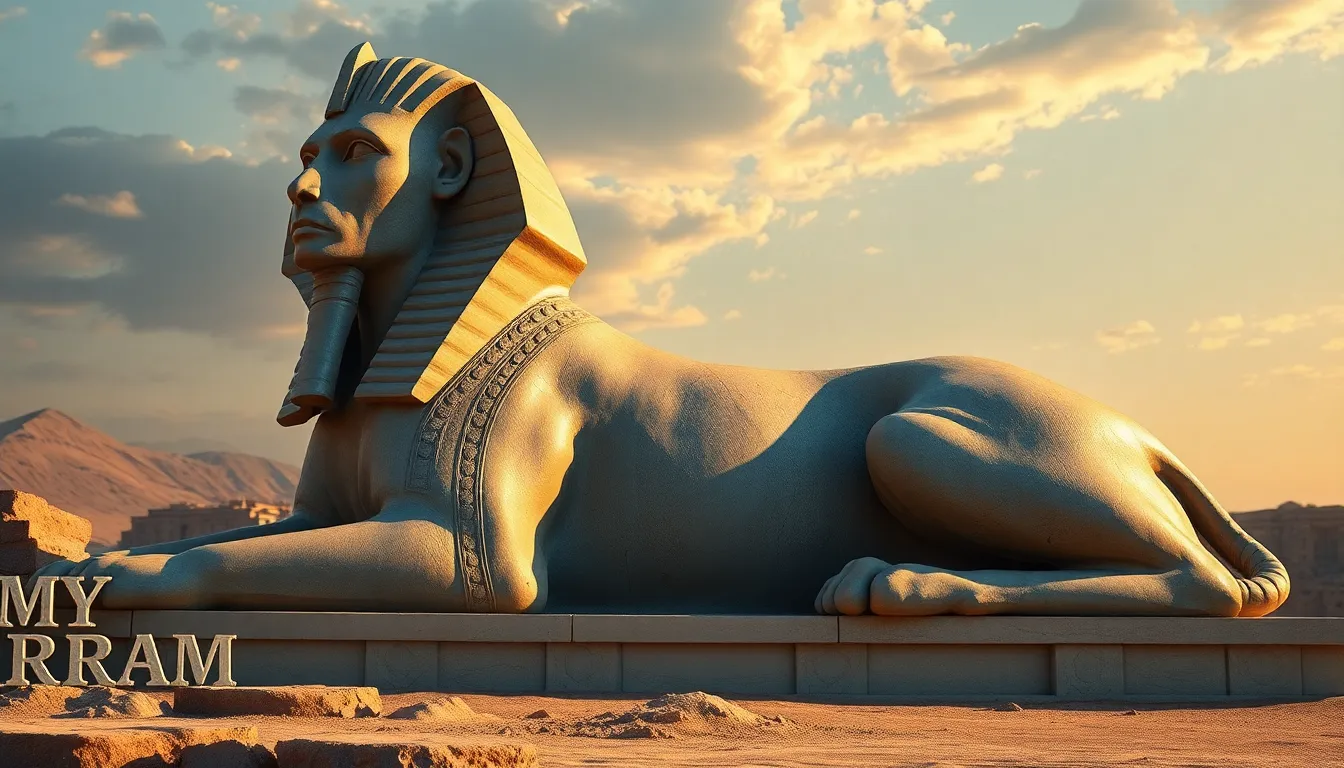The Sphinx as a Symbol of Wisdom and Knowledge
I. Introduction
The Sphinx is one of the most iconic figures in mythology, representing a fusion of human intelligence and animal instinct. Its historical significance stretches across cultures, primarily in ancient Egypt and Greece, where it served as a powerful symbol of wisdom and knowledge.
Across various cultural contexts, the Sphinx embodies dual representations of wisdom and knowledge, often depicted as a guardian of sacred truths. This article aims to explore the Sphinx’s symbolism, unveiling its rich historical and cultural layers.
II. The Historical Context of the Sphinx
A. Origins in Ancient Egypt
The Sphinx originated in ancient Egypt, with the Great Sphinx of Giza being one of the most renowned examples. Constructed during the reign of Pharaoh Khafre around 2500 BCE, this monumental statue has captivated the imagination of countless generations.
B. Architectural Significance and Design Features
The Great Sphinx is carved from limestone and stands at 66 feet high and 240 feet long, featuring the body of a lion and the head of a human. This design represents strength and intelligence, embodying the pharaoh’s divine status. The Sphinx’s alignment with the stars and the sun also highlights its cosmic significance.
C. Role in Ancient Egyptian Mythology and Culture
In ancient Egyptian mythology, the Sphinx was often associated with the sun god Ra and the concept of protection. It was believed to guard the entrances to temples and tombs, preventing unworthy souls from entering. The Sphinx’s presence reinforced the importance of wisdom and knowledge in navigating the afterlife.
III. The Sphinx in Mythology
A. The Sphinx in Greek Mythology: The Riddle of the Sphinx
In Greek mythology, the Sphinx takes on a different form, famously known for its riddle: “What walks on four legs in the morning, two legs at noon, and three legs in the evening?” This riddle symbolizes the stages of human life and tests the wisdom of those who encounter it.
B. Symbolism of the Sphinx as a Guardian of Knowledge
The Sphinx in Greek culture acts as a guardian of knowledge, challenging individuals to demonstrate their intellect and understanding. Failure to solve the riddle resulted in dire consequences, further emphasizing the importance of wisdom.
C. Comparative Analysis with Other Mythological Creatures
- Chimera: Another mythical creature symbolizing chaos and danger.
- Griffin: A fusion of lion and eagle, representing strength and vigilance.
- Cerberus: The three-headed dog guarding the underworld, highlighting the boundary between life and death.
IV. The Sphinx as a Symbol of Wisdom
A. Characteristics Associated with Wisdom in Ancient Cultures
Wisdom is often characterized by several key traits, including intelligence, insight, and sound judgment. In many ancient cultures, wise figures are depicted as mentors or guardians of sacred knowledge.
B. Interpretations of the Sphinx’s Features as Symbols of Wisdom
The Sphinx’s human head symbolizes intellect, while its lion body represents strength and courage. Together, these features create a harmonious balance of physical prowess and mental acuity, making it a fitting symbol of wisdom.
C. The Sphinx’s Role in Promoting Philosophical Inquiry
The Sphinx challenges individuals to think critically, promoting philosophical inquiry. Its riddles and enigmatic presence encourage the pursuit of knowledge, urging seekers to delve deeper into the mysteries of existence.
V. The Sphinx and Knowledge in Art and Literature
A. Depictions of the Sphinx in Art Throughout History
The Sphinx has been depicted in various art forms, from ancient sculptures to modern paintings. Artists often explore its dual nature, emphasizing its role as both a protector and a challenger of knowledge.
B. Literary References and Their Implications for Knowledge
Literature has long drawn upon the symbolism of the Sphinx. In works such as Sophocles’ “Oedipus Rex,” the Sphinx’s riddle serves as a pivotal moment, highlighting the intertwining of fate and knowledge.
C. Influence on Modern Interpretations of Wisdom and Knowledge
The Sphinx continues to influence modern interpretations of wisdom, often serving as a metaphor for the complexities of understanding and the journey towards enlightenment.
VI. The Sphinx in Contemporary Culture
A. The Sphinx’s Role in Modern Symbolism and Representation
Today, the Sphinx remains a powerful symbol in contemporary culture, representing the quest for knowledge and the importance of wisdom in an ever-changing world.
B. Sphinx Imagery in Popular Media and Literature
From films to literature, the Sphinx’s imagery is frequently utilized to evoke themes of mystery and intellectual challenge. Its enigmatic nature continues to captivate audiences, inspiring narratives that explore the pursuit of knowledge.
C. The Ongoing Relevance of the Sphinx as a Symbol of Wisdom
As a symbol of wisdom, the Sphinx encourages a deeper understanding of the world and ourselves. Its legacy persists, reminding us of the importance of knowledge in navigating life’s complexities.
VII. Challenges to the Sphinx’s Symbolism
A. Debates Surrounding the Interpretation of the Sphinx
Despite its revered status, the Sphinx’s symbolism is not without debate. Scholars and cultural critics often question the interpretations of its role as a guardian of knowledge.
B. Critiques of the Sphinx’s Association with Wisdom and Knowledge
Some critiques suggest that the Sphinx’s riddles can also represent the barriers to knowledge, challenging the notion that wisdom is always accessible. This duality prompts a reevaluation of how we understand wisdom.
C. The Impact of Cultural Appropriation and Misrepresentation
As the Sphinx has been adopted across various cultures, issues of cultural appropriation and misrepresentation arise. Acknowledging its origins is essential in appreciating its true significance.
VIII. Conclusion
In conclusion, the Sphinx stands as a profound symbol of wisdom and knowledge, encompassing rich historical and cultural narratives. Its significance transcends time, offering insights into the complexities of understanding and the pursuit of truth.
The enduring legacy of the Sphinx calls for a deeper exploration of such symbols in our world, encouraging us to appreciate their multifaceted meanings and the wisdom they impart.




